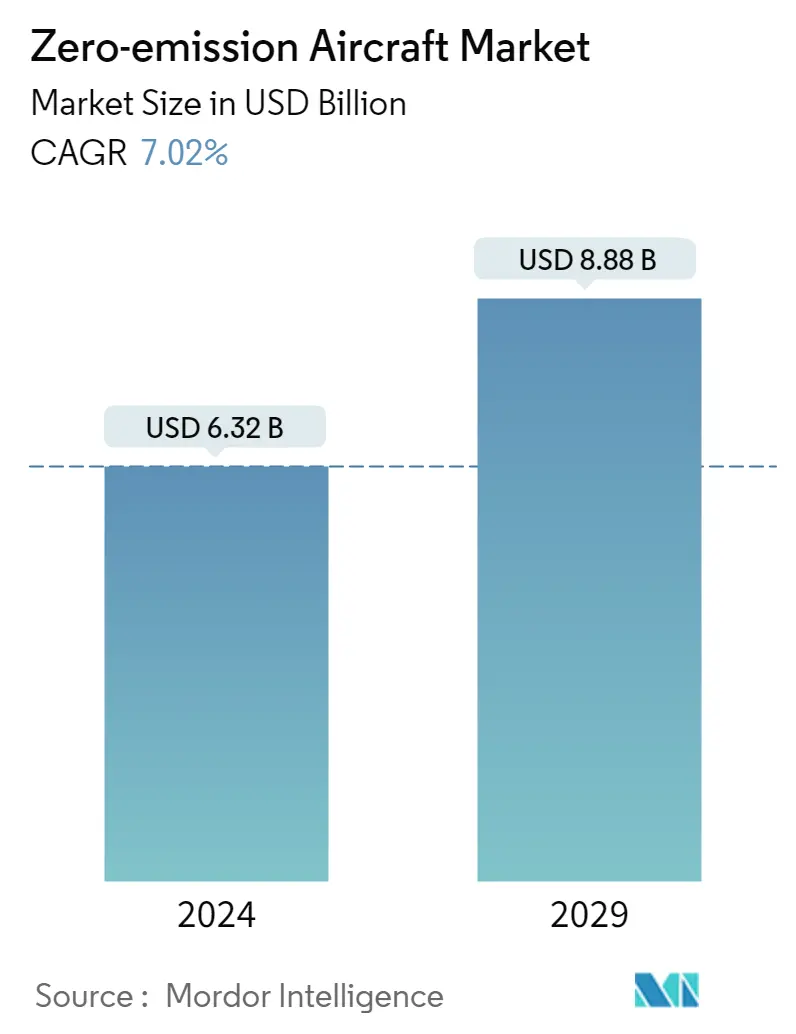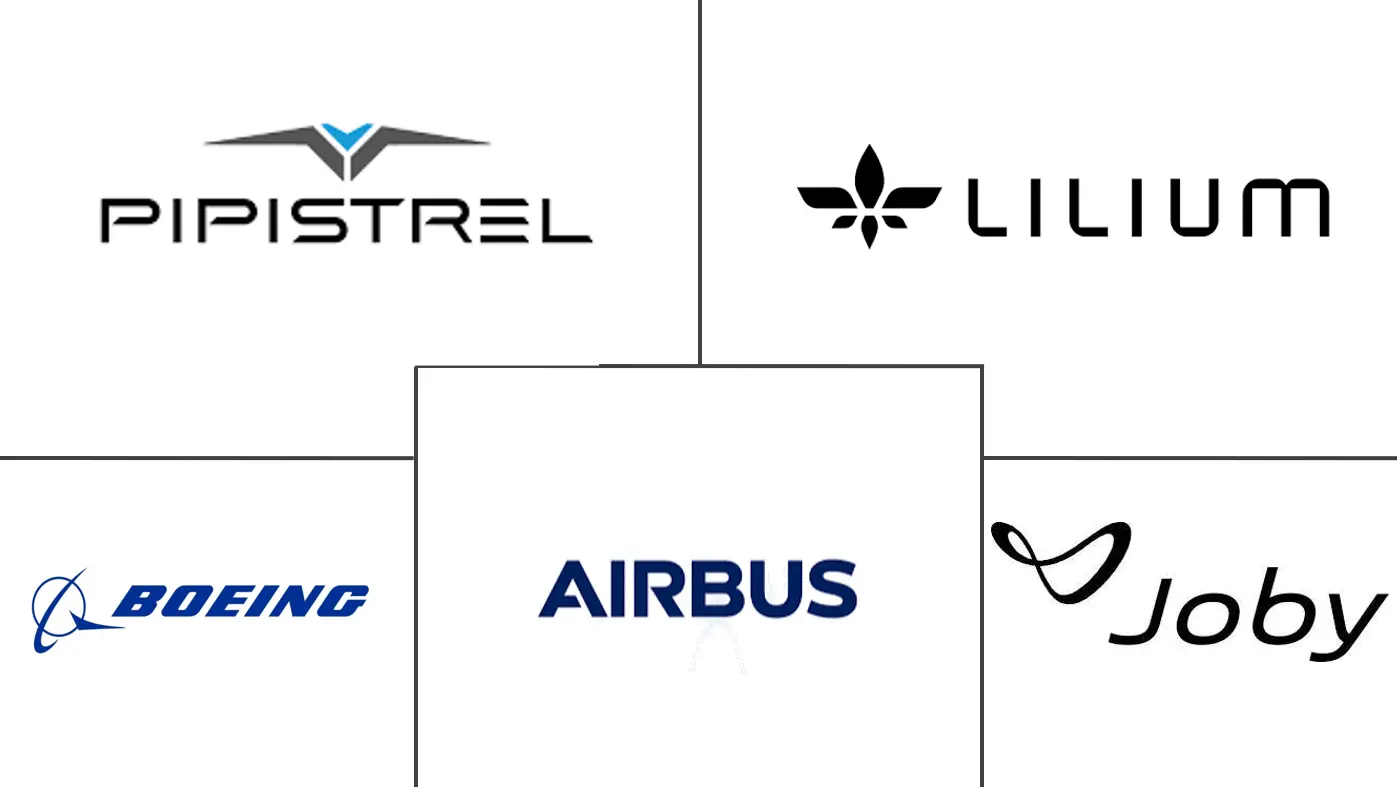Market Size of Zero-emission Aircraft Industry

| Study Period | 2019 - 2029 |
| Market Size (2024) | USD 6.32 Billion |
| Market Size (2029) | USD 8.88 Billion |
| CAGR (2024 - 2029) | 7.02 % |
| Fastest Growing Market | North America |
| Largest Market | North America |
Major Players
*Disclaimer: Major Players sorted in no particular order |
Zero-Emission Aircraft Market Analysis
The Zero-emission Aircraft Market size is estimated at USD 6.32 billion in 2024, and is expected to reach USD 8.88 billion by 2029, growing at a CAGR of 7.02% during the forecast period (2024-2029).
The outbreak of the COVID-19 pandemic disrupted the commercial and general aviation market due to travel restrictions. It also had an impact on the economy and resulted in several aerospace companies to pause funds towards innovative projects. Such decisions have temporarily impacted the growth of the zero-emission aircraft market. However, as aircraft operators looking to reduce their operational costs and carbon emission, there will be significant growth in investment, testing, and adoption of all-electric aircraft during the forecast period.
Increasing stringency on the emission regulations has made manufacturers shift towards zero-emission concept. Engine manufacturers will play a vital role for the aviation industry to move towards the new concept. Sustainable aviation fuel (SAF) is also an important part of the aviation roadmap to reduce the industry's CO2 emissions as companies like Airbus and Boeing are targeting flights on 100% SAF.
Beyond technology challenges, the aviation industry's transition will require the regulatory and infrastructure ecosystems to change. Cross-industry collaboration will be required to drive down infrastructure and production costs, which will be mutually beneficial and help speed up development of the zero-emission aircraft.
Electric aircraft has penetrated the general aviation market. However, its adoption in long-haul commercial aviation is still far away from becoming reality soon with major developments expected in the later half of the forecast period.
Zero-Emission Aircraft Industry Segmentation
The aviation sector is investing in green technology. A global effort is underway with international airlines pouring millions into innovation being developed by green tech pioneers. Zero-emission aircraft is one such concept that has gained popularity in recent past.
The zero-emission aircraft market is segmented by application and geography. By application, the report has been segmented into commercial and general aviation, and military aviation. The report also covers the market sizes and forecasts in major regions. The market sizing and forecasts have been provided in value (USD million).
| Application | |
| Commercial and General Aviation | |
| Military Aviation |
| Geography | |
| North America | |
| Europe | |
| Rest of World |
Zero-emission Aircraft Market Size Summary
The zero-emission aircraft market is poised for significant growth over the forecast period, driven by increasing regulatory pressures and a shift towards sustainable aviation practices. The COVID-19 pandemic temporarily hindered progress by causing delays in funding for innovative aerospace projects. However, the demand for reduced operational costs and carbon emissions is propelling investments in all-electric aircraft. The aviation industry is witnessing a shift towards zero-emission concepts, with engine manufacturers playing a crucial role in this transition. Sustainable aviation fuel (SAF) is also integral to the industry's roadmap, with major players like Airbus and Boeing aiming for flights powered entirely by SAF. The transition to zero-emission aircraft necessitates changes in regulatory and infrastructure ecosystems, requiring cross-industry collaboration to reduce costs and accelerate development.
North America and Europe are at the forefront of the zero-emission aircraft market, supported by the presence of major aerospace companies and regulatory frameworks conducive to innovation. Companies such as Rolls-Royce and ZeroAvia are making significant strides in developing energy storage systems and hydrogen-electric aircraft, respectively. The market is becoming increasingly fragmented, with numerous startups and collaborations driving advancements in aircraft development. Partnerships, like those between Rolls-Royce and Tecnam, highlight the industry's focus on all-electric and hybrid-electric propulsion systems. Prominent players, including PIPISTREL d.o.o., Bye Aerospace, and Joby Aviation, are actively working on prototypes and short-range aircraft, contributing to the market's expansion.
Zero-emission Aircraft Market Size - Table of Contents
-
1. MARKET DYNAMICS
-
1.1 Market Overview
-
1.2 Market Drivers
-
1.3 Market Restraints
-
1.4 Porter's Five Forces Analysis
-
1.4.1 Threat of New Entrants
-
1.4.2 Bargaining Power of Buyers
-
1.4.3 Bargaining Power of Suppliers
-
1.4.4 Threat of Substitute Products
-
1.4.5 Intensity of Competitive Rivalry
-
-
-
2. MARKET SEGMENTATION (Market Size by Value - USD million)
-
2.1 Application
-
2.1.1 Commercial and General Aviation
-
2.1.2 Military Aviation
-
-
2.2 Geography
-
2.2.1 North America
-
2.2.2 Europe
-
2.2.3 Rest of World
-
-
Zero-emission Aircraft Market Size FAQs
How big is the Zero-emission Aircraft Market?
The Zero-emission Aircraft Market size is expected to reach USD 6.32 billion in 2024 and grow at a CAGR of 7.02% to reach USD 8.88 billion by 2029.
What is the current Zero-emission Aircraft Market size?
In 2024, the Zero-emission Aircraft Market size is expected to reach USD 6.32 billion.

